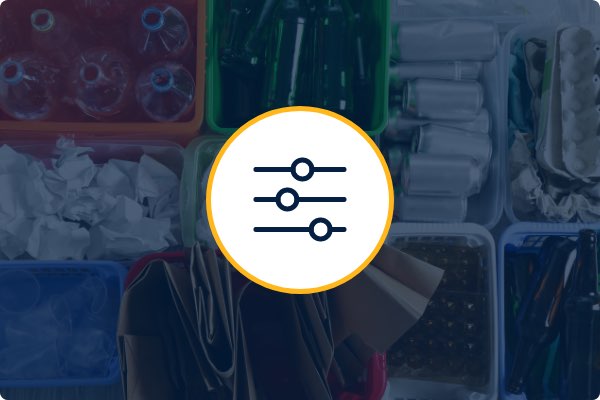We’ve used the three-pronged strategy of use less plastic, recycle more, and support system-wide improvements to set sustainable packaging goals that we continue to work toward globally, across North America and in the U.S.

In 2016, Walmart announced its global goal to achieve 100% recyclable packaging for our Private Brands by 2025. In 2019, we expanded that goal to 100% recyclable, reusable, or industrially compostable packaging for our private brands and to use at least 17% post-consumer recycled content globally in our private brand plastic packaging. We are also taking action to eliminate problematic or unnecessary plastic packaging and move from single-use towards reuse models where relevant by 2025.
While our commitment is focused on our Private Brands, we also encourage national brand suppliers to tackle plastic and packaging waste. Our Project Gigaton program invites suppliers to avoid emissions — as well as drive down waste — by reducing unnecessary packaging, optimizing packaging materials and increasing the reuse and recycling of packaging.

Walmart U.S. and Sam’s Club are working toward multiple goals under each of the three strategies.
Use Less Plastic
- Eliminate all PVC and polystyrene packaging in Walmart’s own Private Brands by 2025.
- Eliminate unnecessary plastic packaging in Walmart’s own Private Brand products.
- Provide customers with more alternatives to single-use plastic household products, including utensils, plates and cups.
- Promote the use of reusable shopping bags for our customers at Walmart U.S. stores, including adding them as a prominent feature at the check-out counter.
Recycle More
- Commit to 100% recyclable, reusable, or industrially-compostable packaging in all Walmart’s own Private Brands by 2025.
- Develop Supplemental Guidance Documents to Support Walmart’s Recyclability and Recycled Content Goals for our suppliers to help them reduce unnecessary plastic packaging.
- Target at least 20% post-consumer recycled content in Private Brand packaging by 2025.
- Label 100% of our Walmart U.S. food and consumable Private Brand packaging with the How2Recycle® label by 2022. Encouraging our national brand suppliers to make similar commitments through our Project Gigaton Platform.
- Maximize operational plastics recycling towards zero waste by 2025 goal and close the loop on it where viable.
- Continue offering customers the opportunity to drop off plastic bags and plastic film materials for recycling at our Walmart stores.
Support System-wide Improvements
- Work with governments, manufacturers and other stakeholders, to increase plastic recycling.
- Become a signatory to the Ellen MacArthur Foundation’s New Plastics Economy Global Commitment, which commits to eliminating all problematic and unnecessary plastic items.
- Support the major NGO/industry consortia studying the issue (Ellen MacArthur Foundation and Ocean Conservancy’s Trash Free Seas Alliance).
See the progress we’ve made so far on these Sustainable Packaging Goals.
Challenges
While plastic may provide numerous benefits relative to other materials (low cost, shelf life, portability, flexibility, etc.), society’s ability to collect and recycle plastic waste has failed to keep up with exponential increases in plastic production, which has grown to nearly half a billion tons per year. The following is a sampling of challenges we know we can't solve alone, but we’re opening our doors to a more collaborative approach across the industry.
According to Geyer, Jambeck and Law (2017), approximately 35% of plastic produced is used in packaging, the vast majority of which is used once and then discarded. And less than 14% of plastic packaging is recycled globally, as noted by the Ellen MacArthur Foundation. This low number is likely driven by a combination of consumer confusion about where/how to recycle, weak collection infrastructure, and broken links between plastic design and scalable processing infrastructure.
Packaging plays an important role in protecting and delivering quality products to our customers. But in most cases, packaging is simply a means to transport a product. Once the end user has removed the product packaging it becomes waste. The World Bank estimated that the world produced 3.5 million tons of solid waste per day in 2010, and that amount is projected to double by 2025.
Plastic may sometimes be the best solution for packaging in terms of overall carbon footprint – but we want to find end-of-life solutions. There are barriers to growing plastic recovery markets. For instance, “plastic” is not one material – it is multiple base materials with many different kinds of additives. Even if the material can be collected, these variations make sortation and processing difficult.
Globally, recycling infrastructure at the household or municipal level is weak. For example, less than half of U.S. homes have access to household recycling infrastructure. Even when materials are collected, sortation is problematic. Consumers often put non-recyclable materials in bins, and technology at sortation facilities has not kept pace. China recently imposed a ban on plastic waste from foreign countries, specifically around low value plastics and contaminated (improperly sorted) bales. Additional challenges also include, but are not limited to: economic viability, variability of quality recycled material, and industry and policy fragmentation.

Goals
We’ve used the three-pronged strategy of use less plastic, recycle more, and support system-wide improvements to set sustainable packaging goals that we continue to work toward globally, across North America and in the U.S.

Progress
We continue to collaborate with suppliers customers and communities to push toward our global, North American and U.S. sustainable packaging goals. The following represents our progress as of the end of FY2020, estimated based on supplier reports of primary packaging.

Resources
Walmart aims to reduce environmental and social impacts of Private Brand and National Brand packaging, while maintaining our ability to deliver quality products to customers.



